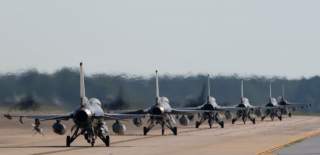The Air Force Has Given a Test F-16 a Powerful APG-83 AESA Radar
Nice.
The APG-83 is designed to be installed without making any major modifications to the jet.
The U.S. Air Force (USAF) has recently installed the Northrop Grumman APG-83 Active Electronically Scanned Array (AESA) radar on its own F-16.
Noteworthy as reported by Alert 5 Weblog, the first operational F-16 to have the radar is a jet belonging to the Republic of China Air Force.
However photos published by Edwards Air Force Base (AFB) show #87-0392 getting the new radar as well. The bird is currently assigned to the 416th Flight Test Squadron (FLTS).
The 416th FLTS in fact continually conducts developmental testing to enhance the warfighting capabilities of the F-16 Fighting Falcon. Currently one focus of the F-16 testers is the integration and testing of the new radar as part of the F-16 Radar Modernization Program (RMP), explains Kenji Thuloweit, 412th Test Wing Public Affairs, in the article 416th FLTS working to upgrade F-16 radar.
According to its manufacturer, Northrop Grumman, the APG-83 Scalable Agile Beam Radar is a fifth-generation radar that is an Active Electronically Scanned Array fire control radar. It is intended to replace currently used APG-66 and APG-68 radars and provide the F-16 with advanced capabilities similar to fifth-generation fighters like the F-22 Raptor and F-35 Lightning II. Moreover the radar has the ability to operate in dense electronic environments, simultaneous multi-mode operations and enhanced system availability through increased reliability, maintainability and supportability.
The APG-83 is designed to be installed without making any major modifications to the jet.
“The APG-83 will be a form, fit and function modification that will operate within existing space, power and cooling capabilities of the platform,” pointed out Lt. Col. Chris Keithley, 416th FLTS commander.
The APG-83 could satisfy a need for F-16 users to counter increasingly sophisticated and technological threats with increased bandwidth that would allow the F-16 to detect, track and identify greater numbers of targets faster, and at greater distances.
“With the modernization comes increased capabilities,” said Michael Powell, 416 FLTS, project lead. “It is a more modern and stable radar.”
Powell added the F-16 RMP at the 416th FLTS is ongoing with several ground and flight tests performed with the APG-83 in the past two years. Data collected will be used by the Air Force to determine if the radar can be implemented operationally in the future.
The F-16 Fighting Falcon is a compact, multi-role fighter aircraft. It is highly maneuverable and has proven itself in air-to-air combat and air-to-surface attack. It provides a relatively low-cost, high-performance weapon system for the United States and allied nations.
This article by Dario Leone originally appeared on The Aviation Geek Club in 2017.
Image: DVIDShub.

